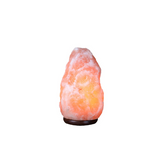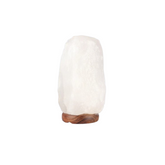Are Himalayan Salt Lamps Safe for Pets and Children?
Are Himalayan Salt Lamps Safe for Pets and Children?
Himalayan salt lamps are popular for their soft amber glow, relaxing ambiance, and association with wellness. However, many pet owners and parents worry whether these decorative items pose risks at home. Are salt lamps safe to keep around dogs, cats, and children or do they present hidden hazards?
This guide explores pet safety, child safety, and the potential toxicity of salt lamps. We’ll review placement strategies, safety precautions, and expert insights so you can enjoy your lamp responsibly.
Ensure your salt lamp is placed out of reach this is a key part of effective childproofing in living spaces.
What Are Himalayan Salt Lamps?
A Himalayan salt lamp is crafted from large blocks of pink Himalayan salt, typically sourced from the Khewra Salt Mine in Pakistan. A bulb inside heats the salt, producing a soft glow. Advocates claim these lamps:
- Purify air by releasing negative ions
- Reduce stress and improve mood
- Enhance sleep quality
While some of these benefits remain scientifically unproven, salt lamps are primarily used for ambiance and décor.
Are Himalayan Salt Lamps Toxic to Pets?
Salt Ingestion Risks
The biggest safety concern for pets is salt toxicity. Cats and dogs are naturally curious and may lick the lamp. Too much salt can cause hypernatremia (dangerously high sodium levels).
Symptoms of salt poisoning in pets include:
- Vomiting or diarrhea
- Excessive thirst and urination
- Lethargy or confusion
- Seizures (in severe cases)
According to the Pet Poison Helpline, salt ingestion of more than 4 g/kg can be fatal for dogs and cats.
Important: Never allow your pet to lick a Himalayan salt lamp.
Placement Strategies for Pet Safety
- Keep lamps out of reach. Place them on high shelves, desks, or wall-mounted brackets.
- Avoid floor-level placement. Cats can jump, so ensure stability to prevent tipping.
- Cover when unsupervised. Some owners use lamp covers or cages to block access.
If you notice your pet licking the lamp, remove it immediately and contact a vet.
Are Himalayan Salt Lamps Safe for Children?
Choking and Burn Hazards
For babies and toddlers, salt lamps present two main risks:
- Small detachable parts (cords, bulbs, or chunks of salt) may pose choking hazards.
- Heat exposure from the bulb inside can cause burns if touched after hours of use.
Excessive Salt Ingestion
Just like pets, children should never lick or consume salt directly from the lamp. Even small amounts may lead to electrolyte imbalance.
Best Practices for Child Safety
- Supervise closely. Never leave young children unattended with a lamp.
- Keep cords secured. Prevent tugging or tripping hazards.
- Choose stable surfaces. Avoid placing lamps on wobbly tables or near crib edges.
Practical Safety Tips for Families
Here are best practices to enjoy your lamp without risking pet or child safety:
- Choose the right bulb wattage. Avoid overheating by using the recommended E12 bulbs.
- Keep the lamp dry. Salt absorbs moisture (hygroscopic), making it prone to sweating. Moisture may damage furniture and attract curious pets.
- Clean regularly. Wipe with a dry cloth to prevent salt residue.
- Check cords and plugs. Faulty wiring may pose electrical hazards.
- Use at night for ambiance. Shorter usage times reduce heating risks.
Comparing Salt Lamp Risks: Pets vs. Children
| Risk Factor | Pets (Dogs/Cats) | Children (Infants/Toddlers) |
|---|---|---|
| Salt ingestion | High risk → Toxicity possible | Moderate risk → Upset stomach |
| Burn hazard | Low (unlikely to touch lamp) | High (curiosity leads to touching) |
| Choking hazard | Low (larger salt blocks) | High (small parts, cords, bulbs) |
| Electrical hazard | Moderate (chewing cords) | Moderate (pulling/tugging cords) |
Expert Opinions and Scientific Evidence
- Veterinary guidance: The ASPCA warns that excess sodium is toxic to pets.
- Pediatric recommendations: The American Academy of Pediatrics advises against leaving heated decorative lamps in children’s play areas.
- Scientific evidence: While claims about health benefits are debated, the risks of ingestion and burns are well documented.
FAQs
1. Can salt lamps kill cats?
Yes, if a cat consumes enough salt, it can lead to sodium poisoning. Always place lamps out of reach.
2. Do salt lamps leak water?
They may "sweat" in humid environments. This can create slippery surfaces, posing risks if placed near children’s play areas.
3. Are salt lamps safe in bedrooms?
Yes, if kept on stable surfaces, away from cribs, and out of pets’ reach.
4. Can children touch a salt lamp briefly?
Yes, but avoid prolonged contact after the lamp has been on for hours, as it may feel warm to the touch.
Final Thoughts
Himalayan salt lamps are safe for households with pets and children if used responsibly. The key is prevention: avoid direct access, prevent licking, and maintain safe placement. While the lamps may enhance ambiance and relaxation, safety should come first.
If you’re interested in learning more about the broader wellness uses of salt lamps, see our benefits of Himalayan salt lamps guide. For aesthetic inspiration, explore our home décor ideas with salt lamps.





